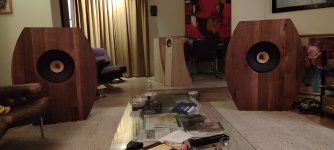made out of 3 cm thick oak.
The more mass also better the bass.
I really don't like the looks, name and maybe also the sound like your experience of the Frugel's.
Very optimistic price for pair
More than a new, matched pair of EnABLed A10.3, inclding shipping to the EU. About 2x the price new.
dave
and regarded slightly better than the 11MS.
Depends who you ask and
The demo that Jeff referenced was at the lasy VI diyFEST, and was A11ms in Seasick, A10.3eN (matched/EnABLed), and Jordan Eikona in Hawking Memorial Monolith.
Overall A11ms was judged best except for how they threw an image/soundstage. Jordan had unacceptable top end )to me at least) and was a step behind the other two.
I do have a set of A11ms i want to EnABL i expect that to bring up their image/soundstage. Some minor issues on stock units with their top end can be easily tamed (at least to a large extent).
dave
And although they sound really nice they are lacking in deep and tight bass.
They need at least a wall behind, and then there is damping. I suggest Pensil would do better with that placement.
dave
Well, Dave, I find it a bit rude at this forum to post that price, but "as long as there are sheep there will be wool"
I tried that.The bass is very deep.But not as dry/tight(sounds weird🥴,).
Incorrect amount of damping. Too little.
dave
Use a dsp to highpass your speakers at fb , this cleans up the bass below fb and you will be able to play louder overall.I tried that.The bass is very deep.But not as dry/tight(sounds weird🥴,).
I experimented with stuffing for a few days.Think I managed to get the best out of them .
Play with baffle step correction using a dsp at 400 Hz , that way you can put your speaker away from the front wall.
This can also be done with passive components.
Last edited:
Some advices that works for me:I made some Frugel-horn XLs.
And although they sound really nice they are lacking in deep and tight bass.
Bass out of an original Sibelius are dry like a bag of Sahara sand.And that bass goes way down.
I hear them on a regular basis at my brother' s .
There probably is a reason Harley made them or has them made out of 3 cm thick oak.
Set the tuning point (fb) of your speakers to 35 Hz , its a good compromise in most rooms. This is also below lowest E from an electric base. The thickness of the box has ( in my opinion ) little impact in comparison to getting the tuning frequency right for the box, the driver and the listening room resonances.
Very big difference for the better :
Avoid tunefork colorations from the cabinet by making one of each opposite wall thicker, i.e. 19mm and opposite parallell wall 22mm. This can be done afterwards with thin masonite wood pieces that you glue inside the speaker. This will ofcourse make the cabinet volume slightly smaller .
In practice, there will be a clearer articulation in the sound when listening to piano recordings and its easier to hear what the left hand is playing.
Using this technique, even the bad mdf material can sound decent.
Last edited:
Actually Sea Stack, and yes that was the first demo, the second a Chrisb's house. I also thought they were quite good in your room.The demo that Jeff referenced was at the lasy VI diyFEST, and was A11ms in Seasick, A10.3eN (matched/EnABLed), and Jordan Eikona in Hawking Memorial Monolith.
Do you still have the boxes they were in? Would love another listen, maybe even here at home. 🙂I do have a set of A11ms i want to EnABL i expect that to bring up their image/soundstage.
jeff
They're a 1/4 space - 1/8 space boundary loaded horn variation. Boundary loading is a functional part of the design -move them away and the impedance matching vanishes. A high pass at Fb will increase the rolloff from an initial 2nd order (which is why they motor down quite a long way) to something > 4th order, reducing the usable extension & not initially providing much assistance with excursion until you're below about 32Hz. Being a horn, baffle step is also already largely compensated for by the driver's own response and the broad LF gain BW. I like assisted alignments, to a point anyway, & I've even done a handful for MA, but if you're going down that route, a boundary loaded horn probably isn't the ideal basis.Use a dsp to highpass your speakers at fb , this cleans up the bass below fb and you will be able to play louder overall.
Play with baffle step correction using a dsp at 400 Hz , that way you can put your speaker away from the front wall.
This can also be done with passive components.
Do you still have the boxes they were in?
SeaStack (uncaught autocorrect above)?
Hawking Memorial boxes also, happy to give them away toanyonecan pick them up. It can be tweaked for A10.3 (and 11ms i;d guess).
dave
Oh.And having lived with black Magnepans 3.7i and 1.7 for a few years.These look real pretty.😁The more mass also better the bass.
I really don't like the looks, name and maybe also the sound like your experience of the Frugel's.
- Home
- Loudspeakers
- Full Range
- Pearl Acoustic Sibelius
